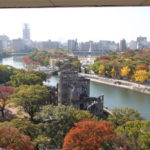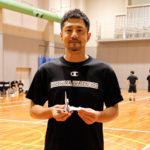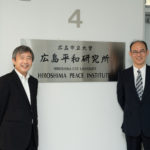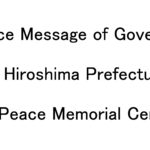II The Development of a Peace Memorial City Construction Plan Based on the Hiroshima Peace Memorial City Construction Law
1 The Contents of the Peace Memorial City Construction Plan
The original reconstruction plan as a legally authorized plan, described in Chapter 3, was revised based on the Hiroshima Peace Memorial City Construction Law and became a new legally authorized plan. This was the “Hiroshima Peace Memorial City Construction Plan,” finalized on March 31, 1952. Let us look at the process to complete this plan. (Table 4-3)
Table 4-3 Various plans for constructing Peace Memorial City
| No. | Name of the Plan | Planned by | Date of issue |
| 1 |
Comprehensive Construction Plan of Hiroshima Peace Memorial City (Draft) |
City of Hiroshima | September 23, 1949 |
| 2 |
Hiroshima Peace Memorial City Construction Project Draft Plan |
City of Hiroshima | October 3, 1949 |
| 3 |
Tentative Construction Plan of Hiroshima Peace City |
Secretarial Division of the City of Hiroshima |
April, 1950 |
| 4 |
Draft Construction Plan of Hiroshima Peace City |
Secretarial Division of the City of Hiroshima |
October, 1950 |
| 5 |
Opinions on the Hiroshima Peace Memorial City Construction Plan |
Hiroshima Peace Memorial City Construction Special Committee |
August 6, 1951 |
In order to establish the Hiroshima Peace Memorial City Construction Plan, city authorities, in particular the Secretarial Division, along with Kenzo Tange and Takashi Asada, concentrated on working on the plan between November 1, 1949 and February 4, 1950. During this period the blueprints for the Peace Park plan, including Chuo Park, were created and included in the “Tentative Construction Plan of Hiroshima Peace City” published in April 1950. It did not use the term “Peace Memorial City” but “City of Peace.” Chapter 1, titled “Hiroshima as a City of Peace,” gives a detailed explanation of the reasons for constructing Hiroshima as a City of Peace. The “peace facilities” included peace greenways, bridges and peace memorial seed nursery1) along with a Peace Hall and a Peace Park. In addition to cultural facilities (a library, a science museum, an art museum, an open-air theater, and academic facilities) and a children’s center, the plan included recreational facilities (facilities for relaxation, amusements, health, hygiene, sports, and friendly gatherings).
This tentative plan was followed by the Draft Construction Plan of Hiroshima Peace City (October 1950). The characteristic of this draft plan was that the keyword “City of Peace” was repeatedly used. For example, the draft plan discussed “Hiroshima as a City of Peace” and the “major issues in planning the construction of a City of Peace” to elaborate on the philosophy of a City of Peace together with the Peace City Law and presented specific details of the functions and the area of peace facilities. The “peace facilities” (later called “peace memorial facilities”), a peace park (the combination of Nakajima Park and Chuo Park in the original reconstruction plan), and a peace greenway (later called Peace Boulevard) were proposed in this draft plan.
The Hiroshima Peace Memorial City Construction Special Committee, a committee of experts, issued a 16-page booklet called “Opinions on the Hiroshima Peace Memorial City Construction Plan” (August 6, 1951). This booklet was made as a report to provide advice and proposals as requested by the Mayor of Hiroshima. It included the discussion results from the first meeting of the committee on October 11, 1950 to the fifth meeting on June 5, 1951. What should be noted among the contents is that the report clarified the principles in building a Peace Memorial City, in particular, the vision of constructing “peace memorial facilities.” Also noteworthy is that the planned 100-meter wide road was called “Peace Memorial 100-meter Road.” This shows the intention of trying to obtain high-rate subsidies under the Peace Memorial City Construction Law by naming the facilities to indicate that they contribute to building a Peace Memorial City. In this way, after the Hiroshima Peace Memorial City Construction Law, many concepts for constructing a City of Peace were developed, and the Peace Memorial City Construction Plan was ready to be made a legally authorized plan.
2 Revisions to the Peace Memorial City Construction Plan
The 48th meeting of the City Planning Council of Hiroshima Prefecture, held on March 29, 1952, deliberated and decided on the aspects of city planning including roads, parks and green areas; memorial facilities, cemeteries, sewers, road construction, and land readjustment; and others issues. With regard to the “planning of urban roads,” plans for the construction of 27 roads, including the 100-meter wide Hijiyama-Kogo Line planned in the initial reconstruction plan, were made (Figure 4-b).
In regards to parks and green areas, when the initial plan was made, there had been no progress in the plans for the re-plotting of the land readjustment, so planning parks within the zone was not possible. However, by the time the Peace Memorial City Construction Plan was being formulated, there had been considerable progress in land readjustment, and small parks were incorporated into the plan. Additionally, some large parks that were not included in the initial plan for some reason were added during this stage (Figure 4-c). The initial plan included three large parks, 32 small parks, four green areas, and one cemetery, for a total of 40 parks and green areas; but the number experienced a significant increase, to 88, in the Peace Memorial City Construction Plan, including six large parks, 72 small parks, eight green areas, and two cemeteries. Among those, the plans for the completion of 13.14-hectare riverbank greenbelts in the Eastern Area and 8.18-hectare riverbank greenbelts in the Western Area were particularly noteworthy. Motoujina Park, Hijiyama Park, Ebayama Park, and Sogo Undo Koen (a sports park) had already been built, so the major change to the large parks was removing Nakajima Park from the list of “parks” and making it a “memorial facility.”
As for land readjustment, the initial “Reconstruction Land Readjustment based on the Hiroshima Ad Hoc City Planning Project” had decided to readjust a total land area of 1,322.5 hectares in 1946. However, in 1952 the project was renamed the “Hiroshima Peace Memorial City Construction Project, Reconstruction Land Readjustment” and 1,060.1 hectares of land was designated as area for reconstruction, including 579.0 hectares in the East and 481.1 hectares in the West. The reconstruction of the East was to be implemented by the Mayor of Hiroshima, and the West by the Governor of Hiroshima Prefecture.
With regard to zoning, based on the Building Standards Act, enacted in 1950, the planned industrial zone was divided into quasi-industrial districts and exclusive industrial districts. The area north of the 100-meter wide road in the center of the city and part of the area behind Hiroshima Station were designated commercial zones. The area south of the prison in Yoshijima Honmachi, a part of Tanna, the reclaimed land in Ujina, and the old Yoshijima Airfield were designated quasi-industrial districts.
Another conspicuous decision made by the City Planning Council was the construction of “memorial facilities.” A special framework was made possible by the Peace City Law.
Specific memorial facilities proposed by the council at that time were: a Peace Memorial Park (12.21 hectares) within about 500 meters of the hypocenter, a memorial cenotaph within the park, and Peace Memorial Halls around former Nakajima Honmachi and Tenjin-machi. The total floor area of the Peace Memorial Halls were to be 2,825 tsubo (9,339 square meters), with a 718-tsubo (2,374 square meters) terrace. The Halls included an assembly hall, a memorial display room, and a main building. The previously mentioned, “Draft Construction Plan of Hiroshima Peace City,” referred to such facilities as “peace facilities,” not “memorial facilities.” Initially, the “peace facilities” proposed in the draft plan included a peace arch, a memorial temple, atomic bomb ruins, and an 85-hectare Peace Park (not Peace “Memorial” Park). Compared with the draft plan, the plan proposed by the City Planning Council was significantly scaled down. However, the decision to make “memorial facilities” was unprecedented in Japan. Their construction was made possible, for the first time, by the Peace City Law (Figure 4-1).
3 The Formation Process of the Peace Memorial Park
(1) Peace Memorial Park Competition
With the Hiroshima Peace Memorial City Construction Law came new circumstances. The decision to revise the previous city plan was an important move, as was the design competition that was conducted around this time. This led to a large-scale design and furthered city planning in Hiroshima. In 1949, the city decided to hold a design competition for the Peace Memorial Park when it became clear that the Hiroshima Peace Memorial City Construction Law would pass the Diet. In short, Nakajima Park, one of the large parks proposed in the postwar reconstruction plan was instead made a “peace memorial facility” to give it a special status; and a movement to build a Peace Memorial Museum and a Peace Memorial Hall began as a result of special subsidies from the national government, further demonstrating that the concept of promoting a “peace memorial” city had taken root.
At the Roundtable for the Design Competition for the Hiroshima Peace Memorial Park and Memorial Halls, Kosuke Terasaki, then Director of the Civil Engineering Division of the City of Hiroshima, said, “The details of the design competition were released on May 20, 1949, based on the discussions conducted from around August 1948 on the scope of application, how to realize the concept and other details.”
According to the design policies clarified in the application requirements (or guidelines) the design must: 1) convey the purpose of the project and be adapted to the environment; 2) have an comprehensive plan for the Peace Memorial Halls and the Park; 3) incorporate the design of the landscape, garden paths, a plaza, and trees (maintaining a distinction between coniferous and broad-leaf trees); and 4) contain plans for the Peace Memorial Halls, including meeting rooms for various international conferences, a display hall for the exhibits showing atomic bomb disasters,2) a tower for Peace Bell, an assembly hall that could accommodate 2,000 people, small meeting rooms, offices, a library, and a large cafeteria.
Furthermore, according to the “Current status of the proposed site,” in the June 1949 “Application Guidelines” published in Kensetsu Geppo3) (Monthly Construction Report), “The remains of the former Industrial Promotion Hall are to be appropriately repaired and kept.” This was an extremely important detail, and it is unclear if its importance was fully understood by the competition applicants. In fact, the majority of the plans submitted did not take this into consideration.
(2) Kenzo Tange’s Winning Plan
The plan submitted by Kenzo Tange’s group was selected as the winner of the competition. The postwar design competition drew much attention―particularly because it was a competition held in Hiroshima. Along with the design competition held the year before by the Catholic church in Nobori-cho (today’s Memorial Cathedral for World Peace), it attracted attention as a new trend in the field of architectural design, with the keywords of “Hiroshima” and “Peace.” On July 20, 1949 (July 18 by some accounts) the Peace Memorial Park competition stopped taking applications, and the results were announced on August 6. The Chugoku Shimbun, a daily newspaper based in Hiroshima, published the results the earliest (on August 7). As shown in Figure 4-2, the article titled “The essence of culture in 40,000 tsubo (132,200 square meters): decision on the winning design of Hiroshima Peace Park.” The article said, “…submissions were being taken from all over the country for the Peace Memorial Park and Peace Memorial Hall. The first prize (prize of 70,000 yen) from among 145 entries was awarded to the design jointly submitted by Kenzo Tange, professor (sic) at the University of Tokyo, Takashi Asada, Sachio Otani and Norikuni Kimura (residing in Tokyo).” Second prize went to Toshiro Yamashita (Tokyo), third place to Ryuzo Arai (Yokohama), and honorable mentions went to five groups led by, Kazuo Yamaguchi (Tokyo), Asaji Sugimoto (Tokyo), Yoshinari Kochi and Jiro Fujimoto (Hiroshima), Fumio Hashimoto (Tokyo), and Kokichi Mano (Tokyo). At the time, the competition drew much attention and the architectural design industry in Hiroshima was much interested in this competition. It is notable that a design proposed by a group of architects at Akatsuki Sekkei, a design office in Hiroshima, was selected as a runner-up.
An explanation of the winning plan reads as follows: “In this plan, in the proposed park area of 37,000 tsubo (122,100 square meters), a Peace Memorial Hall (later named Peace Memorial Museum) will be built stretching from east to west, facing south towards the 100-meter wide road that Hiroshima residents are proud of. The Hall is to be connected by corridors between two buildings: the main building and an assembly hall. In the center of the park there is an arched tower, which shall be called a Peace Monument, and trees are to be planted at various places. From the 100-meter wide road, tourists will be able to see the A-bomb Dome, the former Hiroshima Prefectural Industrial Promotion Hall, through the piloti and the arch tower.”
With a supplementary budget in 1949, the construction of the Peace Memorial Park and the building Kenzo Tange called “Hiroshima Peace Center” began. First, the construction of the display hall started in February 1951. This later became the main building of the Hiroshima Peace Memorial Museum. Then the construction of the Peace Memorial Hall, today’s Peace Memorial Museum’s East Building, began in March of that year. The construction took a long time because of the tight budget and the buildings were left unfinished for some time.
On the other hand, the “assembly hall” in the initial plan was not considered as a “memorial facility” unique to Hiroshima, and ineligible for subsidies from the national government. However, with donations from the local business community, the construction of the building started in November 1953, after significant design changes were made by a local architectural firm. The structure would no longer be an assembly hall as initially planned but would now be a public auditorium and hotel.
The difficult time Hiroshima faced in the reconstruction process after the war can be seen in the photograph of the construction of the display hall. While under construction, the museum building was ridiculed as a bird cage as its hollow body was exposed (Photo 4-1). The park itself was still full of homes (which people had been ordered to vacate). These houses were hidden with curtains during the Peace Memorial Ceremony. This also sheds light on another aspect of Hiroshima’ s postwar reconstruction process (Photo 4-a).
In 1955, these buildings were completed one after the other. In March, the earliest building to be completed was the public auditorium, which had started the latest. In May, the Peace Memorial Hall was completed and finally the display hall in August. By 1959, the remaining houses were all cleared from the park and the park was almost complete. In April 1958, the Hiroshima Reconstruction Exposition was held at the Peace Memorial Park and in the Museum. As the population levels surpassed pre-war levels, the reconstruction came to be seen as having made a large amount of progress.
Notes and References
1. It was noted in the Hiroshima Heiwa Toshi Kensetsu Koso Shian (Tentative Construction Plan of Hiroshima Peace City), April 1950, that “to celebrate the hosting of various world-class events and to commemorate visitors from around the world as well as to increase the greenery of the City of Peace, the peace memorial seed nursery will be built to nurture the necessary seedlings.”
2. The wording used at that time.
3. Kensetsu Geppo 1949 Nen 6 Gatsu Go says, “The current proposed site is about 123,750 square meters, including Nakajima-cho and a part of Saiku-machi in central Hiroshima. The main area is the flat delta between the two rivers, and the part across one river has the remains of the Industrial Promotion Hall, which is to be appropriately repaired and kept. The southern end will face the 100-meter road, and the northern end will lead to the T-shaped Aioi Bridge.”
Tags associated with this article








